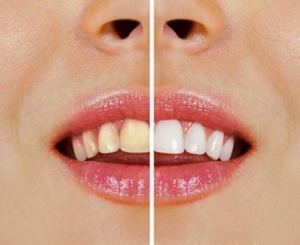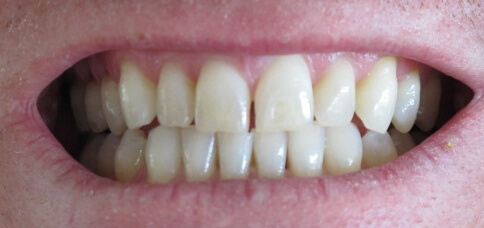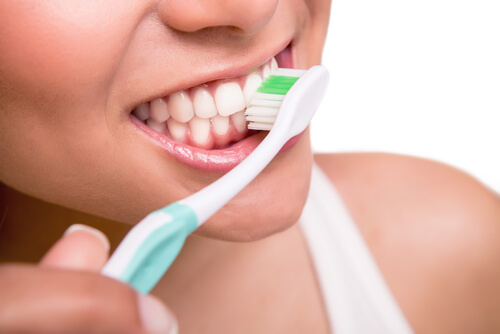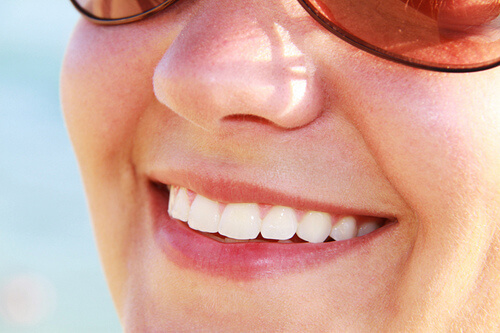How to Easily Whiten Your Teeth with Natural Products

Currently, there are a lot of dental treatments for keeping teeth white and shiny. However, these are prepared with invasive products that end up damaging tooth lining, which is irreversible.
You don’t need to go to such extremes; if you want to whiten your teeth, don’t hesitate in trying the following natural products.
How do teeth become stained?
The enamel lining of your teeth is slightly porous, which “fill” with the food we eat. That’s why if you drink wine or eat blueberries, shortly after your teeth will look purple.
This isn’t a problem as once you brush your teeth, the stained color will go away. However, there are other foods and drinks that stain teeth more permanently, which over time leaves teeth stained a yellow or brownish color, which is truly unattractive.
Colored beverages like coffee, tea, or sodas fall into this list of “stain creators” for teeth.
Cigarettes and poor oral hygiene are also harmful to the smile, which means, they increase porousness in teeth.
Acid from certain foods also damages teeth in certain ways. Eating meat, dairy products, eggs, citrus fruit, refined sugar, beer, artificial sweeteners, carbonated beverages, or vegetable oils worsens the situation. We could also include sweets in this list, but above all, the frequency with which one consumes them.
One typical mistake is brushing teeth just after finishing eating. This may prevent the formation of certain cavities, but it also doesn’t give tooth enamel time to recover.
On the other hand, there are foods that help naturally whiten your teeth. Among which are fruits and vegetables, like pears, apples, carrots, peppers, cauliflower, lettuce, broccoli, and spinach.
Some are good for their fiber, others because their nutrients create a protective film for tooth enamel, preventing them from becoming stained.
Likewise, cheeses are good because they contain proteins and fats to neutralize acids from other foods. This is also because they stimulate saliva production, which contains phosphorus and Calcium, helping return minerals to enamel.
Home recipes for whitening teeth
- For 45 seconds, rub the inside of an orange peel, the white part of the rind, on your teeth. This is called the pith and contains a substance that leaves teeth whiter. Brush one-half hour later.
- Create a strawberry and sodium bicarbonate paste. The strawberries act as a natural whitening agent. All you need to do is crush the fruit and mix it with another ingredient. Apply it to your teeth, and leave it on for 20 minutes, then rinse. Wait for 30 more minutes then brush as normal. Do not use this remedy too frequently (if possible, use just once a week, or every other week).
- Eat one slice of papaya daily, along with one apple. These fruits are great for strengthening Gums while at the same time leaving teeth white.
- Rub a bit of wood ash on your toothbrush and wash as always. Rinse with warm Water and then brush with your normal toothbrush.
- Place two tablespoons of sage leaves in one cup of boiling water. Allow to cool and then use as a mouth rinse after each meal. You could also chew one leaf after eating.
- Mix two tablespoons of oxygenated water with one tablespoon of water. Moisten a cotton ball in a bit of it and gently rub on your stained teeth. Rinse with plenty of water.
- Create a uniform paste with one tablespoon of brewer’s yeast, 2 teaspoons of salt and a bit of water. Brush with this mixture as if it were your toothpaste.
- For two minutes, rub your teeth with the inside of a banana peel. Do this as many times as you like each day. It contains salicylic acid, which has an excellent whitening effect on enamel.
- Make a sodium bicarbonate powder and place it on your toothbrush. Rub every single tooth with it. This could feel strange (just like the wood ash), but a lot of people are sure that this is the best remedy for whitening teeth.
Read also: Reduce Wisdom Teeth Swelling After Removal
Sodium bicarbonate to whiten teeth
A lot of home remedies that were detailed above are very effective if you want to leave your teeth pearly white.
However, all of us agree that there is no better remedy than baking soda. This is the most organic and healthy alternative for your teeth, and you could also stop using toothpaste with it if you prefer.
All you need to do is pour 1/4 tablespoon of sodium bicarbonate in a cup, and moist your toothbrush with water from the faucet.
Dip it in the bicarbonate so that it sticks to it, and brush as if it were toothpaste. If you put a lot on it, don’t worry. This will go away as soon as you wash well with water.
However, remember that you shouldn’t do this several times throughout the month, because excessive use could damage tooth enamel.
Remember, everything in moderation and be careful with the application.
We recommend doing this once every other week, then decrease to once a month, no more.
Advice for having the whitest teeth
- Always keep your mouth clean
- Do not brush too hard
- Use dental floss
- Stop smoking
- Reduce your consumption of coffee, tea, or soft drinks
- Drink with straws
Photos courtesy of Marco Alexandre, torbakhopper, D. Sharon Pruitt, Rupert Taylor Price, JavCon 117, Rory McLeod and Katy Warnery.
All cited sources were thoroughly reviewed by our team to ensure their quality, reliability, currency, and validity. The bibliography of this article was considered reliable and of academic or scientific accuracy.
- Gupta, S., Mandlik, G., Padhye, M. N., Kini, Y. K., Kakkar, S., & Hire, A. V. ija. (2014). Combating inadequate anesthesia in periapical infections, with sodium bicarbonate: a clinical double blind study. Oral and Maxillofacial Surgery. https://doi.org/10.1007/s10006-013-0418-1
- Kleber, C. J., Davidson, K. R., & Rhoades, M. L. (2001). An evaluation of sodium bicarbonate chewing gum as a supplement to toothbrushing for removal of dental plaque from children’s teeth. Compendium of Continuing Education in Dentistry.
This text is provided for informational purposes only and does not replace consultation with a professional. If in doubt, consult your specialist.











